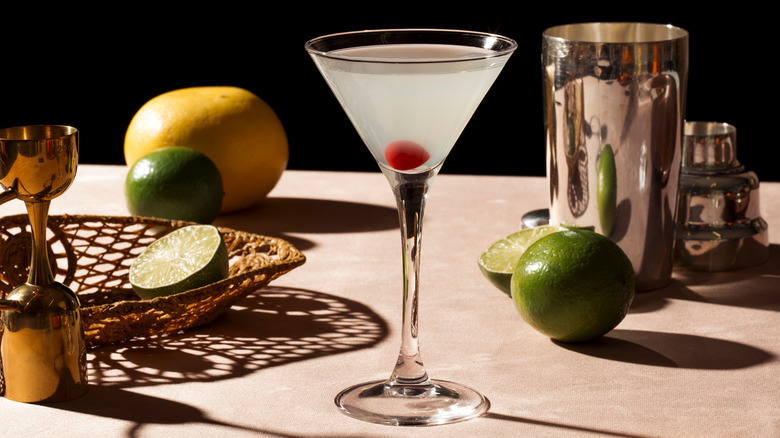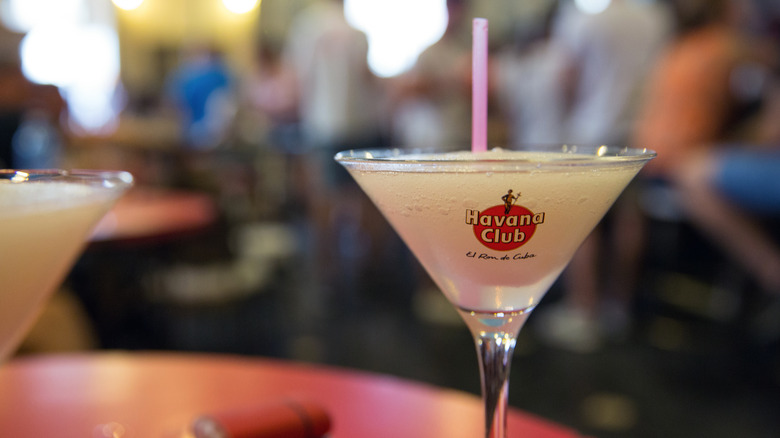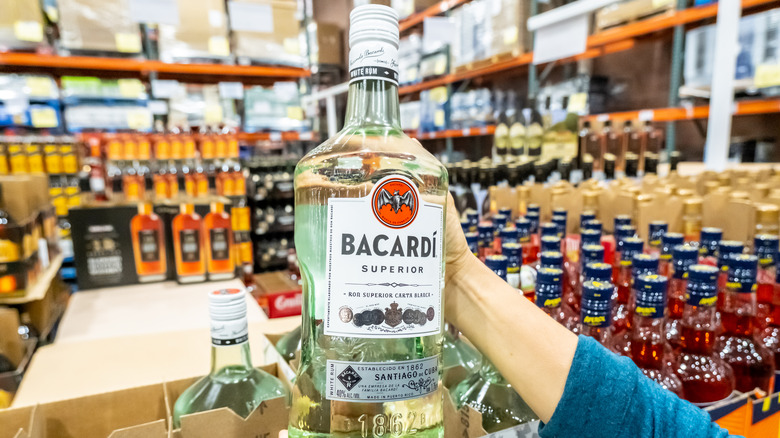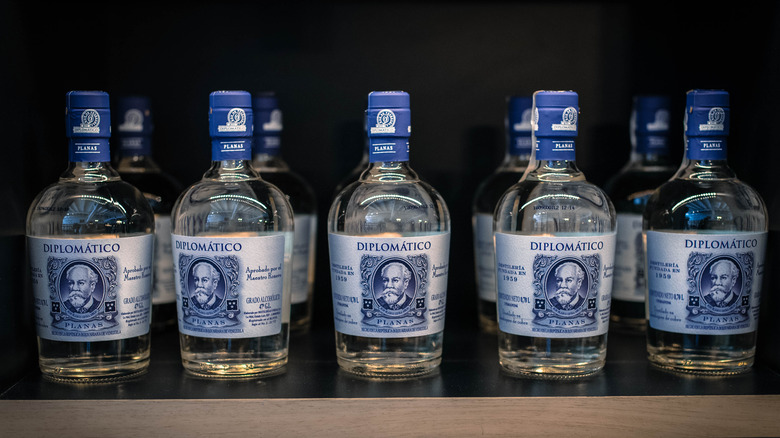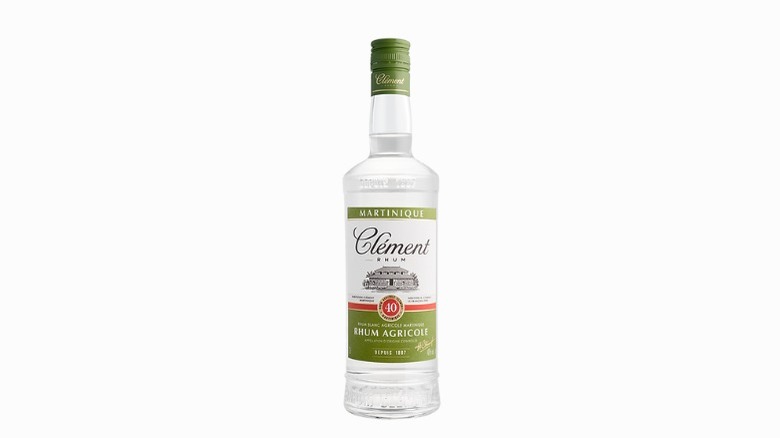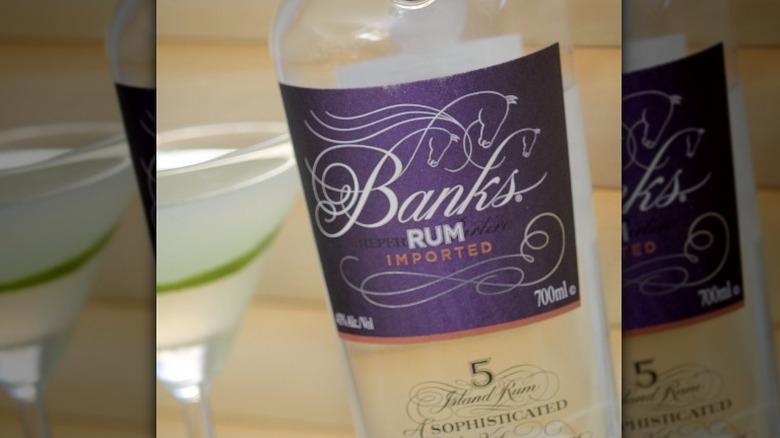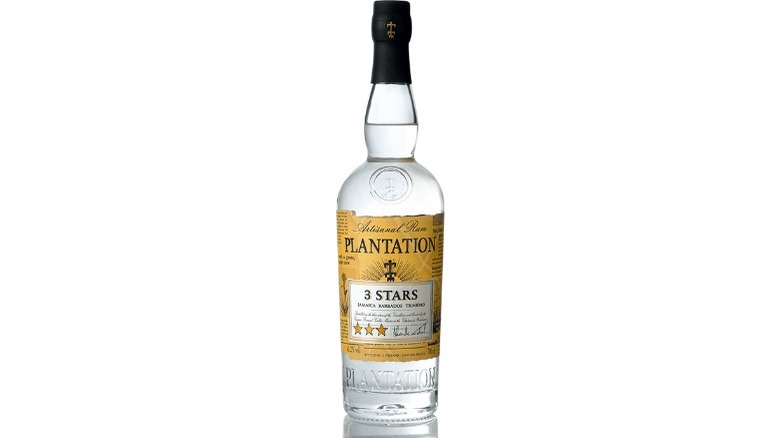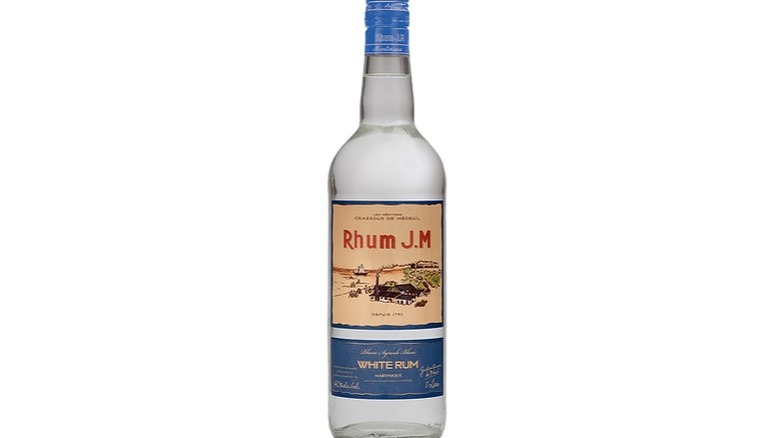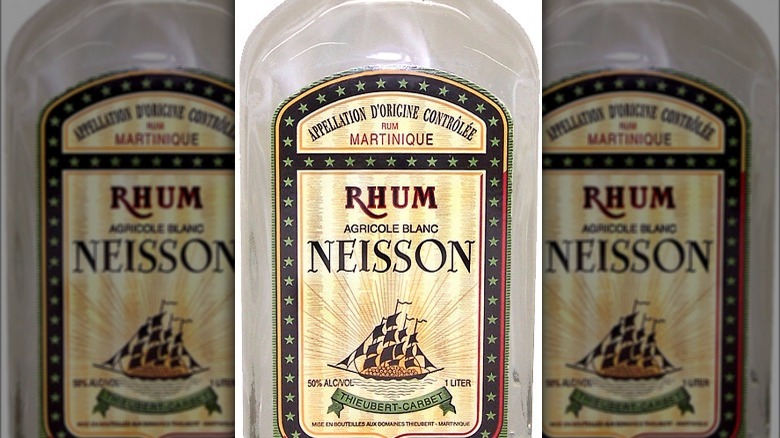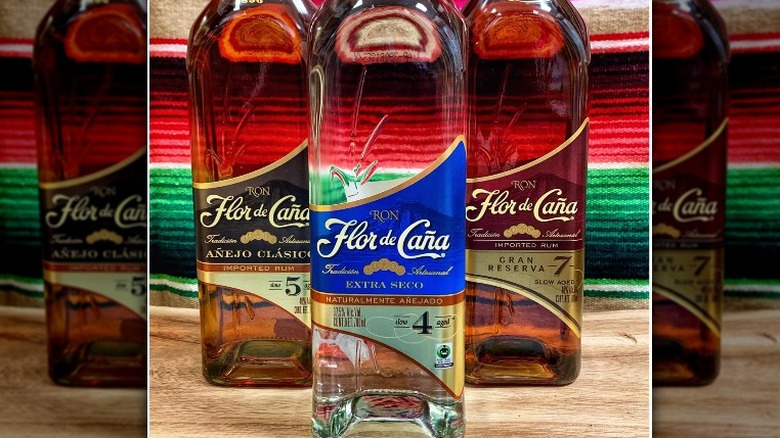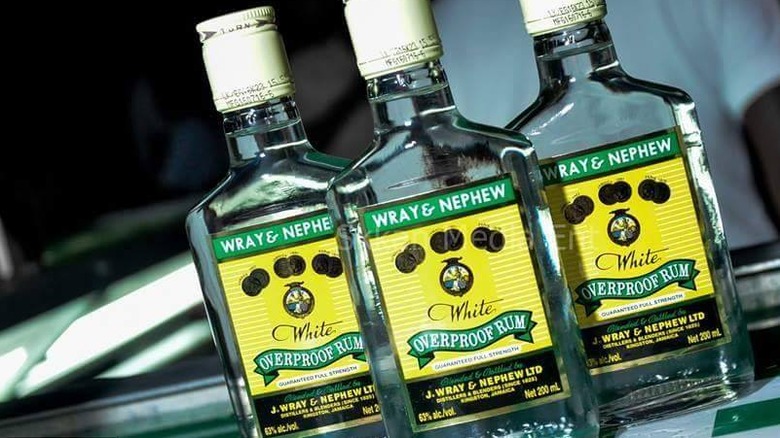10 Best Rums For An El Floridita
Made with rum, lime, and maraschino liqueur — the El Floridita cocktail was created at a Havana bar of the same name and famously inspired by Ernest Hemingway, who, it's fair to say, enjoyed the occasional drink. History is shrouded in mystery. This is particularly true for libations and those who liberally drink them. According to drinking legend, the El Floridita cocktail was a prima facie collaboration between Hemingway and Constantino Ribalaigua Vert, a storied bartender at the El Floridita bar (via NPR). Known in Cuba as the King of Cocktails, Ribalaigua is said to have created more than 200 cocktails, and his skills as a mixologist made his bar a tourist magnet.
According to NPR, the El Floridita daiquiri is a derivative of the Papa Doble — a cocktail named after Hemingway. The famous author's niece Hilary Hemingway told journalists the Papa Doble was created when the author asked Ribalaigua for a house daiquiri but with double the rum and a splash of lime juice, no sugar. Ribalaigua eventually added maraschino liqueur to make the strong drink more palatable, and some recipes call for a bit of grapefruit juice (via Wine Enthusiast). Keeping both the story and respect for the Cuban mixologist in mind, know what you need to make a great El Floridita.
Havana Club 3 Years (or Havana Club Añejo Blanco)
Havana Club is the rum you turn to when seeking an El Floridita that most resemble the original Cuban tipple. But to which Havana Club should you turn? Because there are, in fact, two Havana Clubs.
The rum from Havana Club International is made in Cuba and is most associated with the island nation. The other Havana Club comes from Bacardi International, and it's not made in Cuba. The latter might seem less authentic, but it may be your only option. Cuban rum has been commercially unavailable in the United States for 60 years due to a trade embargo.
Unfortunately, neither rum can claim to be 100% authentic. After the original Havana Club rum was seized during the Cuban Revolution, the current Havana Club International emerged as a venture between the state-owned Cuba Ron and French liquor corporation Pernod Ricard. After the American patent lapsed, Bacardi applied for the Havana Club trademark in 1994, but the matter is still in dispute (via The Washington Post).
So, which should you choose for an El Floridita, assuming you have the choice? A panel from The Washington Post found the 'Cuban' Havana Club 3 Year to be a sweeter rum compared to the Bacardi Añejo Blanco. However, the four-taster panel was split on which one tasted better. Two people said the sweetness in the Cuba-made rum is a cynical ploy meant to appeal to Cuban tourists. The other half said the Cuban-made rum was more flavorful.
Bacardi Superior
Bacardi International was founded as a Cuban company in 1862, and it was based there for 98 years. While revolutionaries seized its Cuban operations in 1960, the company had already shifted much of its operations off the island.
Given the Cuban pedigree of its maker, Bacardi Superior should be considered another go-to rum for the authentic tasting El Floridita, especially for people without access to Cuban rums due to the ongoing trade embargo. As one of Bacardi's flagship rums, Superior is easy to find and should be priced affordably near you.
According to official tasting notes, Bacardi Superior is a very easy drinking rum with subtle accents of lime, almonds, and vanilla. While it brings more to the party than a neutral spirit like vodka, Bacardi Superior doesn't get in the way of other cocktail ingredients. Those who like more complex cocktails won't find a ton to rave about in an El Floridita made with this rum, but if you're not into chin-stroking cocktails, it's a strong, fairly authentic choice.
Diplomatico Planas
Made in Venezuela, Diplomatico Planas may not have a Cuban pedigree. However, this subtle white rum also comes from the Spanish colonial rum-making tradition of using molasses, column still distillation, and charcoal filtering to remove color, per Difford's Guide.
According to company information, Diplomatico is an independent, family-owned distilling brand that manages the entire production chain, from harvesting sugar cane to bottling. Entrenched at the foot of the Andes Mountains, the distillery is located near fresh mountain waters. It mainly uses three sugar cane varieties to make its rums: Venezuela, Romana, and Canal Point. To make Planas, Diplomatico uses molasses with high sugar content but low viscosity and ash content. After distillation, Planas is aged for up to six years.
The resulting rum has been praised for its complexity and intriguing flavors, with notes of grass, oak, and vanilla (via Bespoke Unit). Planas is a very sip-able rum, but that's not why you're here. In an El Floridita, Planas provides a solid herbal and slightly woody backbone on which the other components wrap around. It never gets in the way while adding complexity that knowledgeable cocktail fans appreciate.
Rhum Clement Blanc
Rum is defined as any spirit made from sugar cane — whether it's distilled from molasses or sugar cane juice, whether it's made with a column still or a pot still. Rhum Agricole is a subcategory of rum made from sugar cane juice, not molasses. Also called rhum, this spirit has origins in French-colonized Caribbean islands like Martinique. In fact, the term rhum agricole is French for agricultural rum (via VinePair).
While rhum agricole is made around the world, the French government has established the appellation d'orgine Contrôllée (AOC) for rhum agricole, made in Martinique in 1996. Producers who meet standards related to terroir, production, and other factors can earn the AOC designation, and Rhum Clement is one of only 11 said makers who meet that bar.
Terroir is a big deal when discussing rhum agricole. For example, rhum made from sugar cane grown in volcanic soils tends to have subtle flavors compared to rhum made from can grown in sandy soils, according to Punch. Sporting a volcanic terroir, Rhum Clement Blanc sips of fresh-cut grass, black tea, and unrefined, rustic sugar. As you can probably imagine, these lime and cherry-friendly notes harmonize well in an El Floridita. This is a cocktail for the more sophisticated set.
Banks 5 Island Rum
When deciding on food and beverage options, it's always a good idea to turn to experts in the hospitality industry. When asked, many experts — including some at VinePair — highly recommend Banks 5 Island Rum, especially for use in an El Floridita.
The fact that this rum blend rates highly with industry pros is no accident. Banks Rums launched in 2008 with collaboration from Jim Meehan, a high-profile beverage consultant in New York City. Meehan told The Drinks Business that the Banks Rum brand breathed new life into blended rums, which had largely disappeared since the early 20th century. Meehan argued that the success of Banks 5 Island Rum had inspired other producers to make their own distinctive white rums.
Banks Rum has also taken a more grassroots approach to marketing. While rum brands like Sailor Jerry and Kraken have leaned heavily into advertising, Banks Rum has focused on converting hospitality influencers and flood bloggers, taking a long-game approach.
As the name indicates, Banks 5 Island Rum is a blend of rums from five different Caribbean islands — Barbados, Guyana, Java, Guyana, and Java. Speaking with InsideHook, industry professionals note that this blend has the earthiness of Guyanese rum, the fruitiness of spirits from Barbados, and the lightness of Trinidadian rum. In El Floridita, that worldwide approach to blending translates into a dry, aromatic liquid that supplies flavor accents to the other ingredients.
Plantation 3 Stars
First released by the French company Maison Ferrand in 1999, Plantation Rum takes a unique approach to its products, including the daiquiri-friendly Plantation 3 Stars. After all of the rums in Plantation's line are distilled according to conventions, they are sent to a Maison Ferrand facility in Cognac, France where they are aged in used cognac barrels (via Spirits Review). This is fairly unusual for a rum, as standard practice for aging the spirit is to use old bourbon barrels.
Named for the Trinidadian, Barbadian and Jamaican rums used to make this blend, Plantation 3 Stars fuses three distinctive flavor profiles: buttery, fruity, and respectably funky. After aging and filtering, the resulting rum looks clear, but tastes of subtle baking spices, coffee, and brown sugar.
In an El Floridita, the strong, complex backbone of Plantation 3 Stars stands up well to the slew of other ingredients, playing particularly well off the richness of maraschino liqueur and adding earthiness to bright lime. But despite all the complex minerality, this white rum makes a very drinkable Hemingway-inspired cocktail.
Rhum J.M. Blanc
Credited with the prestigious appellation d'orgine Contrôllée (AOC) by the French government, Rhum J.M. is a Martinique-based brand with a history that dates back to the middle of the 19th century.
In 1845, Jean-Marie Martin bought a sugar factory at the foot of Mt. Pelée and converted it to a distillery that would make rum under a brand bearing his initials: Rhum J.M. In 2002, the brand was acquired and redeveloped by the Martinique-based Groupe Bernard Hayot (GBH) company. In addition to successfully marketing Rhum J.M. as a premium brand, GBH has also made significant investments in no-waste operations.
According to Distiller.com, the company makes its rum from sugar cane that is harvested each spring on its 1000-acre plantation. The cane is pressed within an hour of being harvested, and the resulting juice undergoes natural fermentation for up to four days. After being distilled to 70% ABV in a Créole copper column, the rum rests in stainless steel tanks for three months or more. Water from the estate is then used to reduce the rum to 40% ABV.
Made from volcanic terroir, the grassy, vegetal notes of Rhum J.M. Blanc can get lost in a cocktail with many ingredients. However, the simplicity of El Floridita allows them to shine. The result is a complex beverage that runs the gamut of the produce section — from herbal to vegetal to bright fruits — Rhum J.M. creates a cocktail that tastes fresh-picked.
Neisson Rhum
According to La Maison du Whisky, Neisson has made a name for itself through the bottles of its white rums, and its Rhum Blanc is well suited to creating a strong, tasty El Floridita.
Nestled on the slopes of Mt. Pelée, Neisson is family-owned and the smallest distillery located in Martinique. The distillery has always recognized the value of its volcanic terroir, and this respect drove the company to embrace organic farming practices in 2010. Neisson sources its sugar cane from sixteen fields (per Rum Auctioneer). Each harvest is pressed in a separate still for an on-site blend that accents microscopic differences. The distillery has been certified as AOC by the French government.
While Neisson rums perform well in cocktails, they are smooth enough to be enjoyed neat. But sporting a hefty 100-proof, Rhum Blanc is calling out for something to cut the high octane. The slightly higher ABV serves to make the cocktail closer to what Hemmingway was likely tossing back. In an El Floridita, minimal ingredients still allow the rum's terroir to peek through, and rum aficionados can taste it in clean-yet-rustic botanical flavors. The result is a refreshing tipple that is dangerously drinkable.
Flor de Caña Extra Seco
Located at the base of the San Cristóbal volcano in Nicaragua, Flor de Caña is a distillery that has been owned by the same family for five generations, according to the official information from the company. As if that weren't impressive enough, the distillery has survived volcanic eruptions, hurricanes, a plane crash, a civil war, and nationalizations.
The rums produced by Flor de Caña are just as robust as the distillery behind them. Ideal for various daiquiris is the Extra Seco — a rum blend made from molasses. The bottle used to indicate that it was aged for four years, but now the packaging no longer displays the length of aging. This rum remains a workhorse base for your El Floridita even without knowing the age. Total Wine describes it as a vanilla-forwarded spirit, adding a complementary spice note to the cherry and lime profile.
Less is more with this Nicaraguan rum. When enjoyed neat, the Rum Howler writes that Extra Seco offers woody notes with slight accents of fruit. The clean, dry flavor profile translates to a refreshing El Floridita. As a bonus, Flor de Caña is also one of the more affordable rums out there, at around $18 on Total Wine. Flor de Caña Extra Seco is created carbon-neutral and fair trade certified.
Wray & Nephew Overproof Rum
After a long, hard week working for The Man, you need more than a light, refreshing cocktail. An El Floridita made with Wray & Nephew Overproof Rum is like a thunderclap to the temporal lobe — in the best way possible.
This rum is about more than just alcohol content. Like other Jamaican rums, Wray & Nephew Overproof Rum is made using a pot still, which translates into a slew of funky, deep flavors. Be warned: The combination of flexing guff attitude can be off-putting to the uninitiated (via Liquor.com). For those who can handle it, Wray & Nephew is one of the more unique white rums.
El Floridita's is already sparse on the ingredients list, and no other component is unable to tame this spirit. It erupts with ripe tropical fruit notes, brown sugar and spice, and thick molasses. The result is a full-flavored cocktail with personality, one that rewards attentive drinkers. Be careful and remember that too many El Floriditas with this Jamaican classic will have you sprinting like Usain Bolt. This is pure 126-proof, 63% ABV rum.
